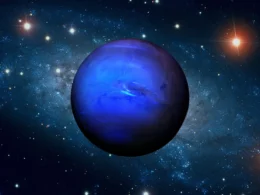« Neptune and Uranus – ice twins that fell out | Space camera zooms in on dark energy riddle »
Fireball on Jupiter after new cosmic impact
By Paul Sutherland on September 11, 2012 10:33 am / no comments
Jupiter is exciting astronomers again after yet another impact produced a brilliant flare in its atmosphere yesterday. The fireball, observed by a visual observer and then confirmed on video, was probably produced by a small asteroid or comet and may suggest that the giant planet is mopping up cosmic debris more often than we realised.
It comes little more than 15 years after fragments of disintegrating comet Shoemaker-Levy 9 hit Jupiter in the first ever collision directly observed between two bodies in the Solar System.
But since then a number of smaller apparent impacts or their scars have been recorded by amateur astronomers monitoring the planet.
The latest event was seen as an apparent explosion in the cloud tops of Jupiter’s North Equatorial Belt by American amateur astronomer Dan Petersen, of Racine, Wisconsin, while observing with his 12-inch telescope.
He reported on the Cloudy Nights forum: “This morning (9/10/2012) at 11:35:30 UT, I observed a bright white two second long explosion just inside Jupiter’s eastern limb, located at about Longitude 1 = 335, and Latitude = + 12 degrees north, inside the southern edge of the NEB. This flash appeared to be about 100 miles in diameter.
“I used my Meade 12″ LX200 GPS telescope and a binoviewer working at 400X for the observation, seeing was very good at the time. I was thinking about imaging Jupiter this morning but decided to observe it instead, had I been imaging I’m sure I would have missed it between adjusting webcam settings and focusing each avi.
“We’ll have to wait and see if a dark spot develops inside the southern regions of the NEB over the next day or two. My best guess is that it was a small undetected comet that is now history, hopefully it will sign its name on Jupiter’s cloud tops.”
Fortunately news quickly came that the event had also been captured on video. Planetary observer George Hall, of Dallas, Texas, had been making mini-movies of the giant planet at around 11.35 UT on September 10, using his 12-inch LX200 GPS telescope. When he looked back through the frames, he found he had recorded the fireball’s flash.
Hall said on his blog: “An apparent object impact captured about 6:35 am on Sept. 10, 2012 from Dallas, Texas USA. The impact was observed by Dan Peterson visually this morning. His observation was posted later on the ALPO_Jupiter forum. When I saw the post, I went back and examined the videos that I had collected this morning.”
George’s video of the latest impact event
Astronomers will now be keen to see whether any dark scar remains in Jupiter’s atmosphere and it is likely that the Hubble Space Telescope will once more be brought into play to help check for this. (Note added 12 September: It was decided not to use on Hubble after ground observations showed no evidence for a visible scar).
Following the impacts of chunks of Shoemaker-Levy, huge scars resembling black eyes were visible even in small telescopes from Earth. The latest collision is unlikely to have produced anything anywhere as near as dramatic, but everyone will want to see.
In July 2009, Anthony Wesley, of Broken Hill, Australia, photographed a dark spot on Jupiter that looked like a smaller version of the Shoemaker-Levy bruises. That scar was later photographed by Hubble in greater detail. Then in June 2010, Wesley and Christopher Go of the Philippines independently photographed a bright flare in Jupiter’s cloud tops.
Then in August the same year, two Japanese amateur astronomers, Masayuki Tachikawa and Aoki Kazuo separately recorded another brilliant flare in the plane’s atmosphere.



